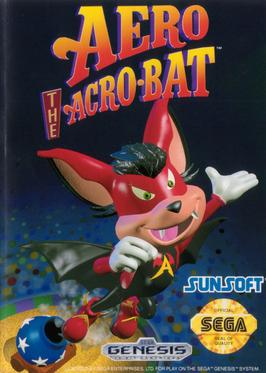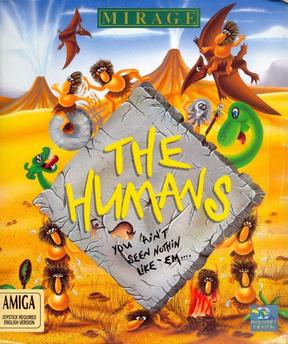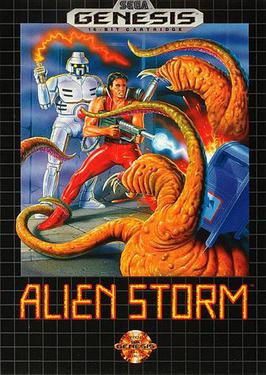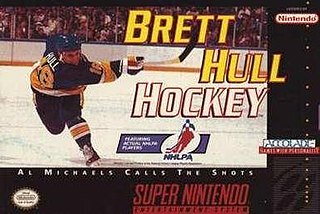
Zoop is a puzzle video game originally developed by Hookstone and published by Viacom New Media in 1995 for the Genesis, Super Nintendo Entertainment System, MS-DOS, Macintosh, PlayStation, Game Gear, and Game Boy, then in 1996 for the Saturn and Jaguar. Zoop has similarities to Taito's 1989 arcade video game Plotting, but Zoop runs in real-time instead. Players are tasked with eliminating pieces that spawn from one of the sides of the screen before they reach the center of the playfield. By pointing at a piece and shooting it, the player can either swap it with the current player color and thus arrange the same color pieces in a row or column, or match the color.

Earthworm Jim is a 1994 run and gun platform game developed by Shiny Entertainment, featuring an earthworm named Jim, who wears a robotic suit and battles the forces of evil. The game was released for the Sega Genesis and Super Nintendo Entertainment System, before being subsequently ported to a number of other video game consoles.

NBA Jam is a basketball video game developed and published by Midway for arcades in 1993. It is the first entry in the NBA Jam series. The project leader for this game was Mark Turmell.
A sports video game is a video game that simulates the practice of sports. Most sports have been recreated with video games, including team sports, track and field, extreme sports, and combat sports. Some games emphasize playing the sport, whilst others emphasize strategy and sport management. Some, such as Need for Speed, Arch Rivals and Punch-Out!!, satirize the sport for comic effect. This genre has been popular throughout the history of video games and is competitive, just like real-world sports. A number of game series feature the names and characteristics of real teams and players, and are updated annually to reflect real-world changes. The sports genre is one of the oldest genres in gaming history.

Phantasy Star II is a science fantasy role-playing video game developed and published by Sega for the Sega Genesis. It was released in Japan in 1989, North America in 1990, and in Europe in 1990. It was later ported to a variety of different platforms. An updated remake, Phantasy Star Generation 2, was released for the PlayStation 2 in 2005 in Japan.

Raiden is a 1990 vertically scrolling shooter arcade video game developed by Seibu Kaihatsu and published by Tecmo in Japan. The game's story takes place in the year 2090, when an alien species known as the Crystals invaded Earth. Players assume the roles of the Vanquish Crystal Defense pilot duo, taking control of two state of the art Fighting Thunders aircraft to defeat the Crystals and save the Earth.

Aero the Acro-Bat is a 1993 video game developed by Iguana Entertainment and published by Sunsoft. It was released for both the Super Nintendo Entertainment System and Sega Genesis. Aero the Acro-Bat, a red anthropomorphic bat, was created by David Siller. In 2002, Metro 3D released a version of the game for the Game Boy Advance, with a battery back-up. The GBA version was titled Aero The Acro-Bat - Rascal Rival Revenge in Europe and Acrobat Kid in Japan. The Super NES version of the game was released on the Wii's Virtual Console in the PAL region on July 23 and in North America on July 26, 2010.

The Humans is a puzzle-platform video game developed by Imagitec Design in Dewsbury, England and originally published by Mirage Technologies for the Amiga in May 1992. It was later ported to other home computers and consoles. The goal of the game varies per level but usually revolves around bringing at least one of the player-controlled humans to the designated end area marked by a colored tile. Doing this requires players taking advantage of the tribe's ability to build a human ladder and use tools such as spears, torches, wheels, ropes and a witch doctor in later levels.

Primal Rage is a fighting game developed and released by Atari Games to arcades in 1994. The game takes place on a post-apocalyptic version of Earth called "Urth". Players control one of seven large beasts that battle each other to determine the planet's fate. Matches feature many of the conventions of fighting games from the era, including special moves and gory finishing maneuvers. Ports were released for home consoles and personal computers. Efforts to perfectly emulate the arcade original have been unsuccessful due to the use of an unusual copy protection method. Toys, comics, a novel and other merchandise tie-ins were produced. More than 1.5 million copies of the game were sold.

Pitfall: The Mayan Adventure is a side-scrolling action-platform video game developed by Activision in conjunction with Kroyer Films and originally published in North America and Europe in 1994. The fourth installment in the Pitfall! franchise, players assume the role of Pitfall Harry Junior as he embarks on a journey through the Mayan jungles of Central America in an attempt to rescue Pitfall Harry, his father and the protagonist of previous entries in the series, from the evil Mayan warrior spirit named Zakelua. Its gameplay mainly consists of action and platforming mixed with stage-based exploration using a main six-button configuration.

The Sega Genesis, also known as the Mega Drive outside North America, is a 16-bit fourth generation home video game console developed and sold by Sega. It was Sega's third console and the successor to the Master System. Sega released it in 1988 in Japan as the Mega Drive, and in 1989 in North America as the Genesis. In 1990, it was distributed as the Mega Drive by Virgin Mastertronic in Europe, Ozisoft in Australasia, and Tectoy in Brazil. In South Korea, it was distributed by Samsung Electronics as the Super Gam*Boy and later the Super Aladdin Boy.

Alien Storm (エイリアンストーム) is a beat 'em up shooter released as an arcade video game by Sega in 1990. It was ported to the Genesis/Mega Drive and Master System. The Mega Drive version was re-released on Wii's Virtual Console in 2007 and was also included on Sonic's Ultimate Genesis Collection for Xbox 360 and PlayStation 3. The game was also re-released on the Nintendo Switch Online + Expansion Pack in 2022.

Legend is a side-scrolling hack and slash beat 'em up video game developed by Arcade Zone and originally published in North America by Seika Corporation in April 1994 and later in Europe by Sony Electronic Publishing on December 21 of the same year for the Super Nintendo Entertainment System. It is the first game to be solely developed by the duo of Carlo Perconti and Lyes Belaidouni at Arcade Zone, who both would later go on to found Toka and HyperDevbox Japan respectively.

Troy Aikman NFL Football is an american football video game originally developed by Leland Interactive Media and published by Tradewest for the Super Nintendo Entertainment System first in North America on August 1994. Officially licensed from the National Football League, it prominently features former NFL player Troy Aikman, who became the first member of the 1993 Dallas Cowboys to have his namesake in a game, followed by his teammate Emmitt Smith in Emmitt Smith Football.

Steel Talons is a 3D combat flight simulator arcade game released by Atari Games in 1991. The player takes on the role of a pilot for an "AT1196 Steel Talons combat helicopter". Steel Talons was ported to the Sega Genesis, Atari Lynx, Atari Falcon, and the Super Nintendo Entertainment System. A Jaguar port was announced, but never released.

Dragon: The Bruce Lee Story is a fighting video game developed and originally published by Virgin Interactive Entertainment in Europe for the Sega Genesis in June 1994. It is based on the 1993 film of the same name, which is a semi-fictionalized account of the life of Hong Kong-American actor and martial artist Bruce Lee. Following the events of the movie, players take control of Bruce Lee across several stages that takes places in different time periods of his life and fight against some of his adversaries.

Brett Hull Hockey is an ice hockey video game developed by Radical Entertainment and originally published by Accolade for the Super Nintendo Entertainment System in North America in January 1994. It prominently features former Canadian-American NHL player Brett Hull and is officially licensed from the NHL Players' Association.

Fever Pitch Soccer, known as Head-On Soccer in North America, is a soccer video game originally developed and published by U.S. Gold for the Sega Genesis/Mega Drive in 1995.

Double Dragon V: The Shadow Falls is a fighting game developed by Leland Interactive Media and published by Tradewest for the Super Nintendo Entertainment System and Sega Genesis in 1994. A port for the Atari Jaguar developed by Telegames was released the following year. It is an American-produced sequel to the Double Dragon series by Technōs Japan, who had little to no credited involvement in the development of the game outside of licensing the IP to the publisher outside Japan.



















